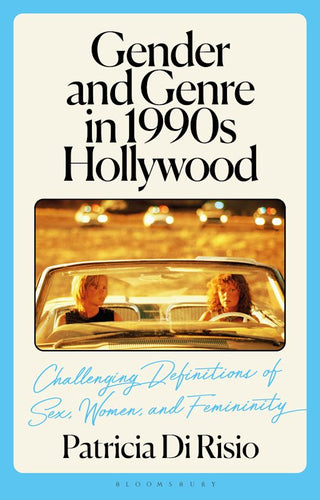Gender and Genre in 1990s Hollywood : Challenging Definitions of Sex, Women, and Femininity
- Unit price
- / per
-
Author:DI RISIO Patricia
-
ISBN:9781350292833
-
Publication Date:December 2024
-
Edition:1
-
Pages:272
-
Binding:Hardback
-
Publisher:Bloomsbury Academic Publishing
-
Country of Publication:United Kingdom


A Back Order button means that we don’t have the book in stock at our store. It may already be on order – or we can order it for you from a publisher or distributor at no additional cost.
As we source items from around the globe, a back-order can take anywhere from 5 days to several weeks to arrive, depending on the title.
To check how long this might take, you’re welcome to contact us and we can provide an ETA or any other information you need. We recommend checking the timeframe before committing to an online order.
Gender and Genre in 1990s Hollywood : Challenging Definitions of Sex, Women, and Femininity
- Unit price
- / per
-
Author:DI RISIO Patricia
-
ISBN:9781350292833
-
Publication Date:December 2024
-
Edition:1
-
Pages:272
-
Binding:Hardback
-
Publisher:Bloomsbury Academic Publishing
-
Country of Publication:United Kingdom
Description
The 1990s was a decade of significant turmoil in Hollywood cinema, which resulted in a watershed moment in the interplay of gender and genre. Patricia Di Risio argues that cinematic representations of unconventional women had an important effect on traditionally male oriented genres, such as the crime thriller, road movie, western, film noir, war film, sci-fi, and horror.
Di Risio analyses seven key films from the decade, including Blue Steel (1990), Thelma & Louise (1991), The Quick and the Dead (1995), Bound (1996), Jackie Brown (1997), G.I. Jane (1997) and Alien: Resurrection (1997), paying particular attention to their use of irony, allusion, and pastiche. She highlights how their female protagonists, a majority of whom are decidedly queer or gender questioning personas, produce an intense crossover in genre conventions, largely driven by their gender rebellion. She examines how a deconstruction of gender simultaneously allows genre hybridity and intertextuality, taking these films into unexpected new directions. In doing so, she delineates a clear line between the unconventional nature of the representation of the female protagonists and innovative changes to genre filmmaking practices.
Adding product to your cart
You may also like
A Back Order button means that we don’t have the book in stock at our store. It may already be on order – or we can order it for you from a publisher or distributor at no additional cost.
As we source items from around the globe, a back-order can take anywhere from 5 days to several weeks to arrive, depending on the title.
To check how long this might take, you’re welcome to contact us and we can provide an ETA or any other information you need. We recommend checking the timeframe before committing to an online order.
You may also like
You may also like
-
The 1990s was a decade of significant turmoil in Hollywood cinema, which resulted in a watershed moment in the interplay of gender and genre. Patricia Di Risio argues that cinematic representations of unconventional women had an important effect on traditionally male oriented genres, such as the crime thriller, road movie, western, film noir, war film, sci-fi, and horror.
Di Risio analyses seven key films from the decade, including Blue Steel (1990), Thelma & Louise (1991), The Quick and the Dead (1995), Bound (1996), Jackie Brown (1997), G.I. Jane (1997) and Alien: Resurrection (1997), paying particular attention to their use of irony, allusion, and pastiche. She highlights how their female protagonists, a majority of whom are decidedly queer or gender questioning personas, produce an intense crossover in genre conventions, largely driven by their gender rebellion. She examines how a deconstruction of gender simultaneously allows genre hybridity and intertextuality, taking these films into unexpected new directions. In doing so, she delineates a clear line between the unconventional nature of the representation of the female protagonists and innovative changes to genre filmmaking practices.
-
-
Author: DI RISIO PatriciaISBN: 9781350292833Publication Date: December 2024Edition: 1Pages: 272Binding: HardbackPublisher: Bloomsbury Academic PublishingCountry of Publication: United Kingdom
The 1990s was a decade of significant turmoil in Hollywood cinema, which resulted in a watershed moment in the interplay of gender and genre. Patricia Di Risio argues that cinematic representations of unconventional women had an important effect on traditionally male oriented genres, such as the crime thriller, road movie, western, film noir, war film, sci-fi, and horror.
Di Risio analyses seven key films from the decade, including Blue Steel (1990), Thelma & Louise (1991), The Quick and the Dead (1995), Bound (1996), Jackie Brown (1997), G.I. Jane (1997) and Alien: Resurrection (1997), paying particular attention to their use of irony, allusion, and pastiche. She highlights how their female protagonists, a majority of whom are decidedly queer or gender questioning personas, produce an intense crossover in genre conventions, largely driven by their gender rebellion. She examines how a deconstruction of gender simultaneously allows genre hybridity and intertextuality, taking these films into unexpected new directions. In doing so, she delineates a clear line between the unconventional nature of the representation of the female protagonists and innovative changes to genre filmmaking practices.
-
Author: DI RISIO PatriciaISBN: 9781350292833Publication Date: December 2024Edition: 1Pages: 272Binding: HardbackPublisher: Bloomsbury Academic PublishingCountry of Publication: United Kingdom
-



